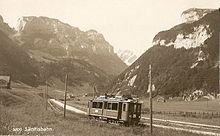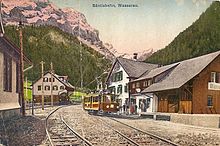Säntisbahn
The Säntisbahn ( SB ) is a former, now merged Swiss railway company, which operated under this name from 1912 to 1939 and never reached its destination, the eponymous Säntis . From 1939 to 1947 the company called Elektro Bahn Appenzell – Wasserauen , while the Federal Office of Transport used the name Appenzell – Weissbad – Wasserauen ( AWW ). The company operated the 6.18-kilometer-long, meter-gauge railway between Appenzell and Wasserauen . It was integrated into the Appenzeller Bahn (AB) in 1947 .
history
idea
As early as the 19th century, the Alpstein area was a popular excursion destination , especially among southern Germans, and the Säntis was their panoramic mountain. On fine Sundays, up to a thousand people crowded the summit, and the small mountain inn was not up to such an onslaught. It was therefore early on to consider opening up the Säntis summit with a cable car analogous to the Rigi Railway , which would have made the costly and laborious seaming for supplying the restaurant unnecessary.
Concessions
As the track in 1886 St. Gallen angles-Appenzell was completed, a group applied for Landammann and National Carl Justin Sonderegger a concession for a (in parts narrow-gauge railway cog railway ) from Appenzell to cart gap , the so-called Säntis Bahn . The Federal Council granted this concession on June 13, 1887 , and the Appenzellerbahn, the planned feeder line to the Säntisbahn, contributed a substantial amount to the project planning costs. In terms of raising capital, however, things did not go particularly well, and the concession was extended several times.
On December 22, 1899, a new concession for an electric tram from Appenzell to Wasserauen was granted, with the condition that the line should be completed by November 19, 1900. Despite the extension of the deadline, construction could not begin and the concession expired on March 15, 1901.
Carl Sonderegger tried again to get a new license, this time for one
- Valley railway from Appenzell to Wasserauen
and a subsequent one
- Mountain railway from Wasserauen to Säntis.
In December 1903 the Federal Council granted such a license; but again two years passed before a modified project was available. Instead of the continuous cogwheel operation from Wasserauen to Säntis kulm , a mixed operation of adhesion and rack to Seealp -Oberstoffel and three wire rope routes from Oberstoffel to Säntiskulm should be built, subject to the replacement of some of these sections by a mountain elevator according to the Feldmann system ( Wetterhorn elevator ). On December 22, 1905 a corresponding change in the license took place.
In the meantime, a project for an electric narrow-gauge and cable car from Urnäsch in the canton of Appenzell Ausserrhoden to the Säntis surfaced , and a tug-of-war followed for the approval of these two variants. Even the National Railway Commission and the Council of States' Railway Commission carried out an on-site inspection in September 1908.
In March 1909, a new concession in favor of the Säntisbahn followed with the deadline for construction until 1912. But even now the financing was stuck, and since the funds were not enough for the whole stage from Appenzell to Meglisalp, the license was changed again, and the railway was divided into four sections
- Appenzell – Wasserauen
- Wasserauen – Seealp
- Seealp – Meglisalp and
- Meglisalp – Säntis
divided. The Federal Assembly also accepted the request of the initiators not to set any binding deadlines for the last three sections.
Railway construction
With the available financial resources, the construction of the valley section from Appenzell to Wasserauen could be tackled on May 1, 1911. There were no structural problems, as the valley railway only had to overcome a height difference of 80 meters on its 6.18 kilometer route. On July 13, 1912, the first section of the planned mountain railway to the Säntis was opened. The construction costs amounted to 1.25 million francs.
It took a full 25 years from the first concession to the opening of the first section of the Säntisbahn.
The First World War and the associated decline in income prevented further construction of the railway, and the planned continuation to the summit was later abandoned.
Rolling stock
The vehicle parking the Santis train consisted of three railcars CFe 2/2 1-3, six two-axle passenger car C 2 11-16, a decked freight wagons K 51 and an open freight cars L 61 used in the 1930s on Sundays for passenger transport has been.
Cable car to the Säntis
In 1927 the idea emerged of reaching the summit of the Säntis from Schwägalp with a funicular that partially runs inside the mountain . On November 11, 1927, Carl Meyer submitted a license application for a cable car from Kräzeren in the municipality of Urnäsch to the Säntis, including the construction of a feeder pass road that leads from Rossfallen in Appenzellerland via Kräzeren to Ennetbühl in Toggenburg .
But there were other projects, such as that of the Toggenburg hotelier Looser for an aerial cableway from Unterwasser to the Säntis and that of engineer Peter from Zurich for the construction of a continuous rack railway from Wasserauen to the Säntis.
Since the license of the Säntis Railway for the three sections from Wasserauen up to the Säntis was still valid due to the non-binding deadlines and in order to allow the still valid license for the expansion of the Säntis Railway to expire, the Federal Council decided on March 6, 1929 the deadlines for fulfilling the concession to mid-1932. Since even the project planning costs could not be collected, this concession, which had existed since 1909, expired at the end of 1930.
After much back and forth, Carl Meyer received the license for his Säntis cable car on September 22, 1933.
On July 1, 1935, the Schwägalp – Säntis (LSS) aerial cableway , or Säntisbahn for short , built by the Leipzig company Bleichert Transportanlagen GmbH, was opened. After more than 50 years of project planning, the plan was to reach the summit of Säntis by train.
Renaming and mergers
The Säntisbahn , which never reached the Säntis summit and thus remained unfinished, was renamed the Appenzell – Wasserauen Electric Railway in 1939 (the Federal Office of Transport ran it as AWW Appenzell – Weissbad – Wasserauen); On January 1, 1947, it merged with Appenzeller Bahn (AB), which in 1988 was renamed Appenzeller Bahnen (AB) after merging with other railways .
literature
- Yvo Buschauer: The train to Säntis; 100 years of the Appenzell – Wasserauen line; First stage of the planned railway from Appenzell via Meglisalp to the Säntis. Appenzeller Volksfreund, Appenzell 2012, ISBN 978-3-9523858-2-1 .
- Stephan Müller: The history of the Appenzeller Bahnen AAB / SGA / AG / SB. Verlag Schläpfer & Co.AG Herisau, 1981, ISBN 3-85882-014-8 (printed in the book: ISBN 3-85882-014-0 )
- Emil Lutz, Peter E. Schaufelberger, Hans Hug: 100 years of the Appenzell Railway. Appenzeller Bahn publishing house, Herisau 1975.
Individual evidence
- ^ Stephan Müller: The history of the Appenzeller Bahnen AB / SGA / AG / SB. Verlag Schläpfer, Herisau 1981, ISBN 3-85882-014-0 , p. 211.
- ^ : Directory of rolling stock 1939. Federal Office of Transport, Bern
- ↑ Museum Association Appenzeller Bahnen, Railway Projects. Accessed November 1, 2012.
- ^ Museum Association Appenzeller Bahnen, preliminary project routes from 1905. Retrieved on November 1, 2012.
- ↑ Museum Association Appenzeller Bahnen: The first stage Appenzell-Steinegg. Accessed on November 1, 2012.




